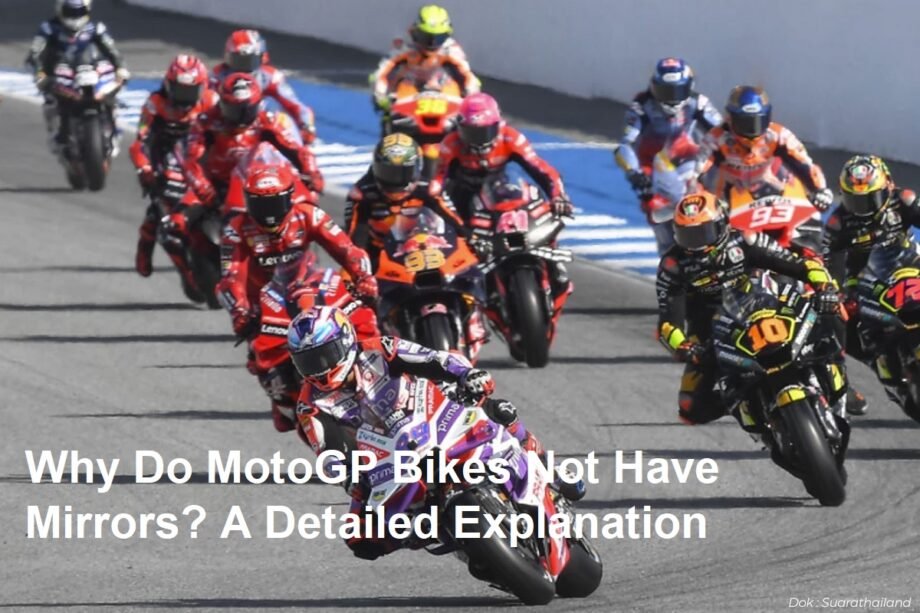Introduction
If you’ve ever watched a MotoGP race, you might have noticed that the bikes do not have rearview mirrors, unlike regular motorcycles or cars. This absence often sparks curiosity among fans and newcomers alike. Why would such high-performance machines, ridden by elite athletes, omit something as seemingly essential as mirrors? In this article, we will explore the reasons behind this design choice, focusing on safety, aerodynamics, and regulatory factors.
The Absence of Mirrors: Not an Oversight but a Choice
MotoGP bikes are purpose-built racing machines designed for maximum speed, agility, and safety on the track. Unlike street motorcycles, they are stripped of non-essential components, including mirrors. The decision to exclude mirrors is deliberate and based on several critical factors:
- Aerodynamics:Mirrors create drag and disrupt airflow.
- Safety:Mirrors can be hazardous in crashes.
- Regulations:Racing rules do not require mirrors.
- Rider Focus:Riders rely on other methods to be aware of their surroundings.
Aerodynamics: Streamlining for Maximum Speed
One of the most important reasons MotoGP bikes do not have mirrors is aerodynamics. At speeds exceeding 350 km/h (217 mph), even the smallest aerodynamic inefficiency can affect performance.
- Reducing Drag:Mirrors protrude from the bike’s body, creating air resistance or drag. This drag slows the bike down and reduces fuel efficiency.
- Improved Stability:The turbulent airflow caused by mirrors can destabilize the bike, especially at high speeds and during cornering.
- Sleek Design:Removing mirrors allows designers to create a more streamlined shape, helping riders achieve better lap times.
Safety Considerations: Mirrors as Potential Hazards
While mirrors are essential for street riding, on the racetrack, they can pose safety risks:
- Crash Risks:Mirrors are fragile and can break off during crashes, potentially causing injury to the rider or others.
- Interference:Protruding mirrors can catch on other bikes or trackside objects during close racing, increasing the risk of accidents.
- Weight and Balance:Although small, mirrors add weight and can affect the bike’s balance and handling, which is critical in racing.
Regulatory and Practical Factors
MotoGP regulations and racing culture also influence the absence of mirrors:
- FIM Regulations:The Fédération Internationale de Motocyclisme (FIM), which governs MotoGP, does not mandate mirrors on racing bikes. The focus is on safety and performance rather than street legality.
- Track Environment:Unlike street riding, riders race on closed circuits with controlled environments, reducing the need for rearview mirrors.
- Rider Awareness:Riders rely heavily on their peripheral vision, track knowledge, and communication with their teams via radio to stay aware of competitors.
Alternative Methods for Rear Awareness
Without mirrors, MotoGP riders use other strategies to maintain situational awareness:
- Head Movement:Riders frequently turn their heads to check behind, especially before overtaking or defending positions.
- Track Familiarity:Extensive knowledge of the circuit and competitor behavior helps riders anticipate moves.
- Team Communication:Real-time updates from pit crews via radio inform riders about nearby opponents and race conditions.
Conclusion
The absence of mirrors on MotoGP bikes is a well-considered design choice driven by the demands of high-speed racing. By eliminating mirrors, teams reduce aerodynamic drag, enhance safety, and comply with racing regulations, all while relying on riders’ skills and communication systems to maintain awareness of their surroundings. This design philosophy highlights the unique nature of MotoGP racing, where every detail is optimized for performance and safety.
Next time you watch a MotoGP race, you’ll understand why those sleek, mirrorless machines are built the way they are—pushing the limits of speed and precision on the track!









